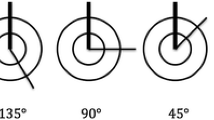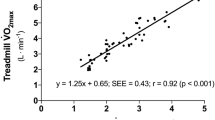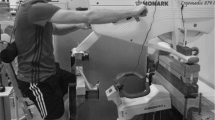Abstract
The purpose of this study was to compare the kinetics of oxygen uptake (V̇O2) during arm cranking with the legs inactive or exercising. Each subject (n=8) performed three exercise protocols: 6-min arm cranking at an intensity of 60% of peak oxygen uptake (V̇O2peak, AC60) and 6-min combined arm cranking and leg cycling in which AC60 was added to on-going leg cycling at an intensity of 20% or 40% of V̇O2peak (LC20 and LC40: AC60LC20 and AC60LC40, respectively). After the onset of arm cranking, V̇O2 tended to increase until the end of arm cranking in all of the three exercise modes. The amplitudes of this increase in V̇O2 were 0.98 (0.18), 0.93 (0.16) and 0.84 (0.12) l.min−1 during AC60, AC60LC20 and AC60LC40, respectively, and there were significant differences between values for each exercise. The data are presented as means and standard deviations. There were no significant differences in the effective V̇O2 time constant, partial O2 deficit, and the difference between the values of V̇O2 measured at 3 and 6 min in the three exercise modes. The present results indicate that the amplitude of the increase in V̇O2 is reduced during arm cranking with the legs exercising, that this reduction becomes greater with increases in the intensity of leg cycling, and that the rate of increase in V̇O2 is not affected by the additional muscle mass of the legs exercising below moderate intensities. The decrease in the amplitude of increase in V̇O2 might be caused by reduction in oxygen supply to the exercising arms due to large muscle mass and/or overlaps of activity of stabilizing muscles during combined arm and leg exercise.


Similar content being viewed by others
References
Barstow TJ (1994) Characterization of V̇O2 kinetics during heavy exercise. Med Sci Sports Exerc 26:1327–1334
Barstow TJ, Jones AM, Nguyen PH, Casaburi R (1996) Influence of muscle fiber type and pedal frequency on oxygen uptake kinetics of heavy exercise. J Appl Physiol 81:1642–1650
Bearden SE, Moffatt RJ (2001) V̇O2 and heart rate kinetics in cycling: transitions from an elevated baseline. J Appl Physiol 90:2081–2087
Bergh U, Kanstrup IL, Ekblom B (1976) Maximal oxygen uptake during exercise with various combinations of arm and leg work. J Appl Physiol 41:191–196
Burnley M, Jones AM, Carter H, Doust JH (2000) Effects of prior heavy exercise on phase II pulmonary oxygen uptake kinetics during heavy exercise. J Appl Physiol 89:1387–1396
Cautero M, Beltrami AP, Di Prampero PE, Capelli C (2002) Breath-by-breath alveolar oxygen transfer at the onset of step exercise in humans: methodological implications. Eur J Appl Physiol 88:203–213
Cautero M, Di Prampero PE, Capelli C (2003) New acquisitions in the assessment of breath-by-breath alveolar gas transfer in humans. Eur J Appl Physiol 90:231–241
Di Prampero PE, Davies CT, Cerretelli P, Margaria R (1970) An analysis of O2 debt contracted in submaximal exercise. J Appl Physiol 29:547–551
Engelen M, Porszasz J, Riley M, Wasserman K, Maehara K, Barstow TJ (1996) Effects of hypoxic hypoxia on O2 uptake and heart rate kinetics during heavy exercise. J Appl Physiol 81:2500–2508
Fukuba Y, Hayashi N, Koga S, Yoshida T (2002) V̇O2 kinetics in heavy exercise is not altered by prior exercise with a different muscle group. J Appl Physiol 92:2467–2474
Gamada K, Nakajima H, Shiozawa S (1996) Lower trunk muscle activity pattern and spinal motion during bicycle pedaling (in Japanese). J Phys Fitness Sports Med 45:441–450.
Gerbino A, Ward SA, Whipp BJ (1996) Effects of prior exercise on pulmonary gas-exchange kinetics during high-intensity exercise in humans. J Appl Physiol 80:99–107
Gleser MA, Horstman DH, Mello RP (1974) The effect of V̇O2 max of adding arm work to maximal leg work. Med Sci Sports 6:104–107
Hayashi N, Tanaka A, Ishihara M, Yoshida T (1998) Delayed vagal withdrawal slows circulatory but not oxygen uptake responses at work increase. Am J Physiol 274: R1268–R1273
Hughson RL, Morrissey MA (1983) Delayed kinetics of V̇O2 in the transition from prior exercise. Evidence for O2 transport limitation of V̇O2 kinetics: a review. Int J Sports Med 4:31–39
Koga S, Shiojiri T, Shibasaki M, Kondo N, Fukuba Y, Barstow TJ (1999) Kinetics of oxygen uptake during supine and upright heavy exercise. J Appl Physiol 87:253–260
Koppo K, Jones AM, Bouckaert J (2003) Effect of prior heavy arm and leg exercise on V̇O2 kinetics during heavy leg exercise. Eur J Appl Physiol 88:593–600
Lamarra N, Whipp BJ, Ward SA, Wasserman K (1987) Effect of interbreath fluctuations on characterizing exercise gas exchange kinetics. J Appl Physiol 62:2003–2012
Miles DS, Cox MH, Bomze JP (1989) Cardiovascular responses to upper body exercise in normals and cardiac patients. Med Sci Sports Exerc 21:S126–S131
Ogata H, Yunoki T, Yano T (2002) Effect of arm cranking on NIRS-determined blood volume and oxygenation of human inactive and exercising vastus lateralis muscle. Eur J Appl Physiol 86:191–195
Pringle JS, Doust JH, Carter H, Tolfrey K, Campbell IT, Jones AM (2003) Oxygen uptake kinetics during moderate, heavy and severe intensity “submaximal” exercise in humans: the influence of muscle fibre type and capillarisation. Eur J Appl Physiol 89:289–300
Rowell (1993) Human cardiovascular control. Oxford University Press, Oxford
Sanchez J, Monod H, Chabaud F (1979) Effects of dynamic, static and combined work on heart rate and oxygen consumption. Ergonomics 22:935–943
Secher NH, Ruberg-Larsen N, Binkhorst RA, Bonde-Petersen F (1974) Maximal oxygen uptake during arm cranking and combined arm plus leg exercise. J Appl Physiol 36:515–518
Secher NH, Clausen JP, Klausen K, Noer I, Trap-Jensen J (1977) Central and regional circulatory effects of adding arm exercise to leg exercise. Acta Physiol Scand 100:288–297
Volianitis S, Secher NH (2002) Arm blood flow and metabolism during arm and combined arm and leg exercise in humans. J Physiol (Lond) 544:977–984
Author information
Authors and Affiliations
Corresponding author
Rights and permissions
About this article
Cite this article
Ogata, H., Yano, T. Kinetics of oxygen uptake during arm cranking with the legs inactive or exercising at moderate intensities. Eur J Appl Physiol 94, 17–24 (2005). https://doi.org/10.1007/s00421-004-1230-2
Accepted:
Published:
Issue Date:
DOI: https://doi.org/10.1007/s00421-004-1230-2




